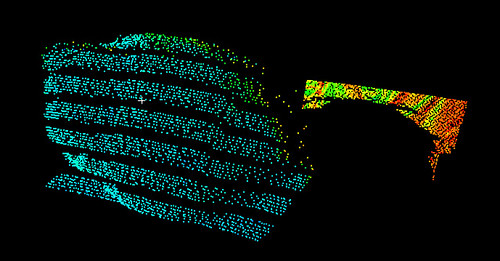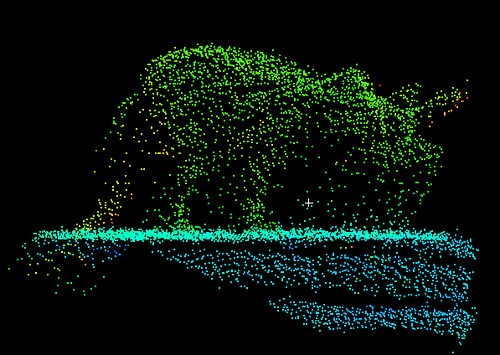As previously mentioned, we have a Leica Scanstation here at UND that is used for scanning large areas for geomorphology projects. I borrowed it yesterday to try out how it did at close range. Although I probably don’t need to say this, things did not go as well as well as planned.
First, the setup:

Since we’re neither scanning a large area nor worrying about repeatability, there was no need for a leveled tripod or targets. The metal base of the scanner is designed for these sorts of applications, so no harm is being done by setting it down on the table like this. The bricks are used to keep the specimen up in front of the scanner, and the computer runs the whole setup. You can see the Triceratops “model” and the gastropod (snail) specimen as well, to judge their size:


I’ll skip over the mechanics of scanning, except to mention that the Leica licensing system is still giving us problems; under one Windows 7 account I couldn’t access the license but under another I could. Such is life with computers!
The problems came from trying to scan at very fine detail. The scanner was set up just under 0.5 m from the objects being scanned, and the resolution (density of scanning points at that distance) was varied as I tried to make things work.
At 0.1 mm point spacing, I ran into this problem (gastropod):

Hitting the limit of the resolution causes this weird striping pattern. This might be okay if the surface were accurately represented, but at this point you lose depth perception as well: the scatter on those stripes averages around 9 mm between the front “surface” and the back, meaning that the surface itself (if I modeled this scan) would vary that much. Not so good.
At 1 mm point spacing, things were better but not so great (gastropod):

The stripes are toned down, but the error is just too large for a decent 3D model to be produced :-(. With 1 mm spacing between points, even if the points were a surface rather than a cloud, this is about the smallest object I would try to scan with it.
Finally, fellow graduate student Ted wanted to try out the Triceratops model. With 1 mm spacing, this is what we got:

Although I’m sure the morphology is incorrect in the details, such a scan fits in nicely with the current horned dinosaur publishing extravaganza going on.
Final verdict: while the Leica Scanstation is good for some things, scanning small fossils is not one of them.

The last one however ended up quite well. Oh, and nice blog by the way.